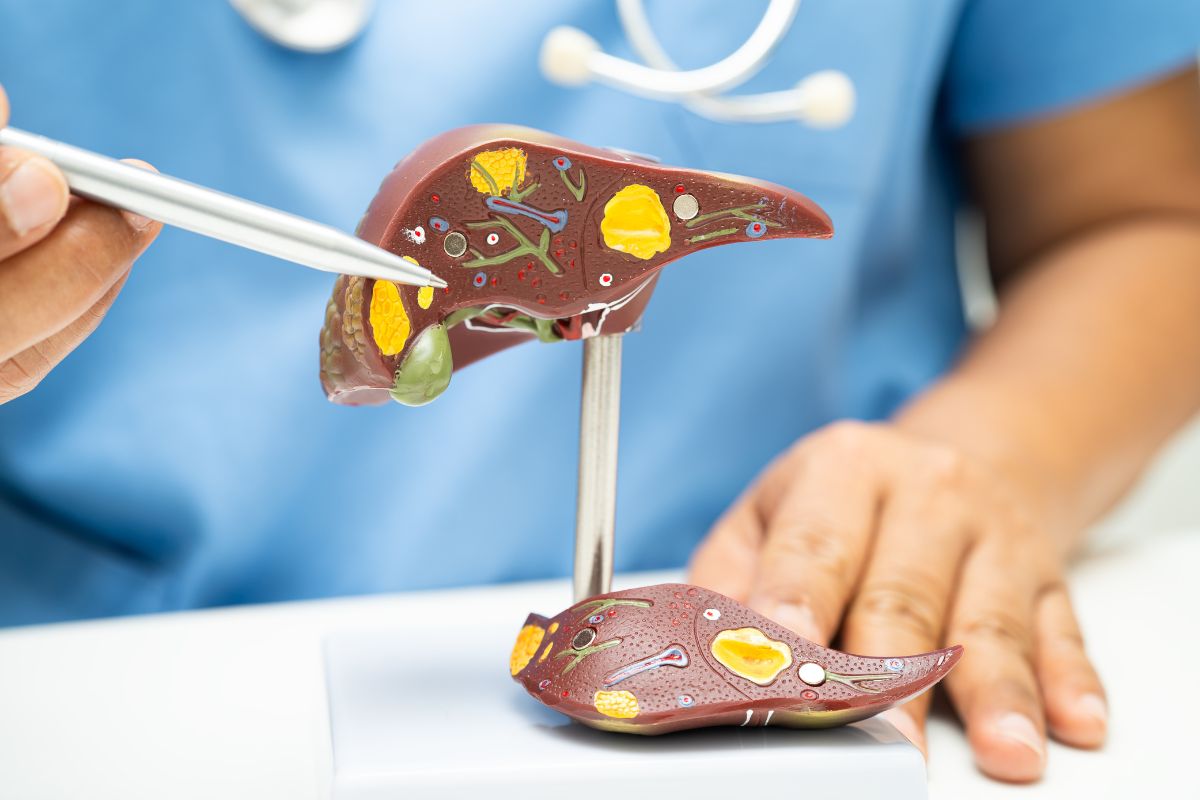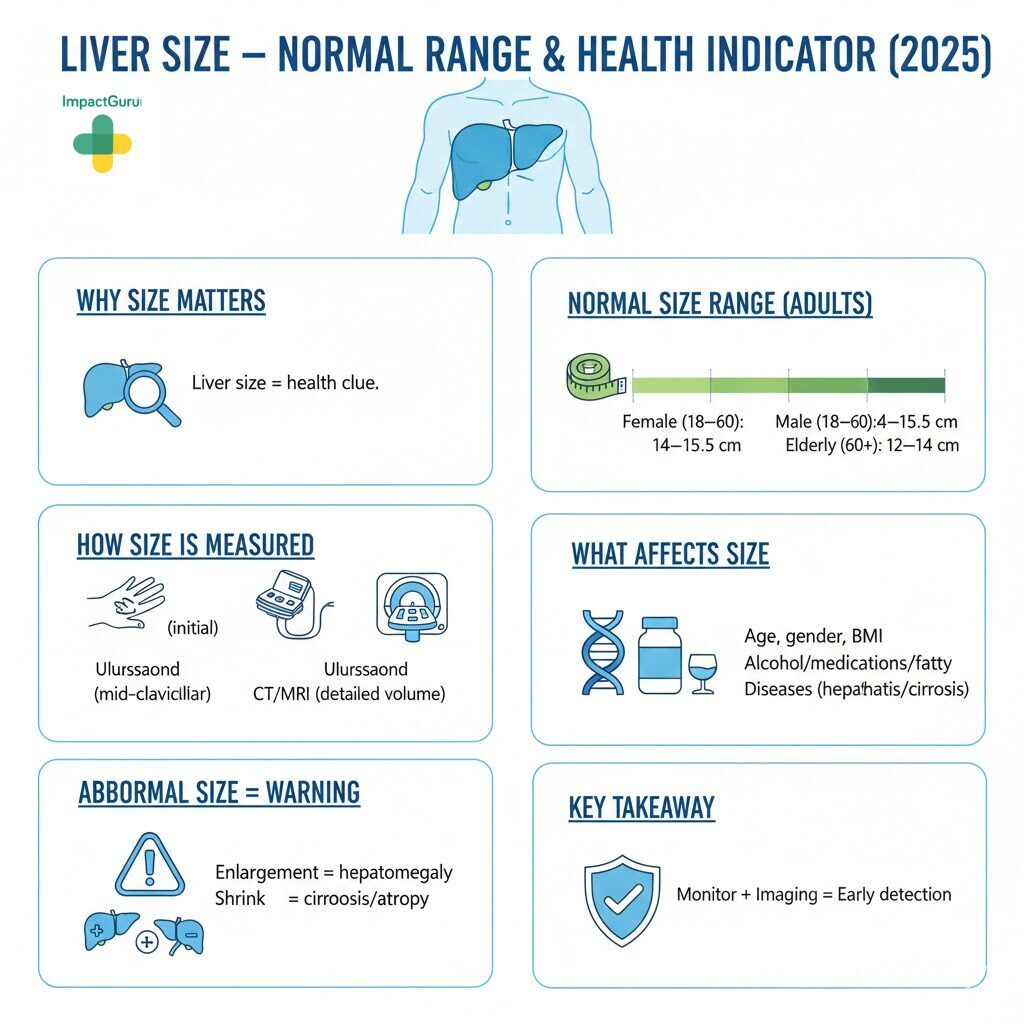Did you know that your liver size can reveal vital insights about your overall health?
As the largest internal organ in the human body, the liver performs over 500 essential functions — including detoxification, metabolism, digestion, and immune regulation.
Any change in its normal size can signal an underlying liver disorder or systemic health issue.
In a healthy adult, the normal liver size typically ranges between 13.5 cm and 15.5 cm, though factors like age, gender, body weight, and medical history can influence this measurement.
Whether you’re undergoing a routine liver ultrasound or evaluating symptoms such as fatigue, abdominal swelling, or jaundice, understanding standard liver dimensions can help you and your doctor identify early warning signs of disease.
When conditions such as fatty liver, cirrhosis, or liver cancer are diagnosed, medical expenses can quickly become overwhelming. In such cases, medical crowdfunding platforms like ImpactGuru help families raise funds for liver treatment and transplants, ensuring timely and affordable care.
This blog explains everything you need to know about adult liver size, including:
- The normal liver size range in centimeters
- How liver size changes with age and body type
- The methods used to measure liver dimensions
- Common causes of liver enlargement (hepatomegaly)
- How to manage and treat liver-related conditions effectively
Read More: Guide to Body Parts Donation in India

Table of Contents
Why Liver Size Matters?

Your liver size isn’t just a number — it’s a crucial indicator of your overall health. The liver performs several vital functions, including filtering toxins, producing bile for digestion, storing essential nutrients, and supporting immune function. Because of its central role in the body, any change in liver dimensions can be an early warning sign of underlying health issues.
A liver that’s too large (hepatomegaly) or too small may indicate conditions such as fatty liver disease, hepatitis, cirrhosis, or even congestive heart failure. Detecting these size changes early allows doctors to diagnose and manage potentially serious diseases before they progress.
Doctors typically measure liver size using ultrasound or imaging scans, especially when patients show symptoms like fatigue, upper abdominal pain or swelling, or yellowing of the skin (jaundice). Understanding your normal liver size range helps healthcare providers identify abnormalities and take preventive action.
Liver size also plays a key role in liver transplantation. To be eligible as a living donor, you must have a healthy liver with a normal size and weight, ensuring both the donor and recipient can regenerate liver tissue safely. This is why liver volume measurements are routinely assessed before a transplant and when placing a patient on a liver transplant waiting list.
Unfortunately, liver transplants can be very expensive, making them unaffordable for many families. In such cases, ImpactGuru’s medical crowdfunding platform helps patients raise funds online to access life-saving liver care without delay.
In the following sections, we’ll explore what a normal liver size looks like across age groups, how doctors measure it, and what it means if your liver size falls outside the healthy range
Read More: Liver Transplant Donor Criteria: Complete Guide for India
Normal Liver Size
The normal size of the human liver can vary depending on a person’s age, gender, height, and body type. In most healthy adults, the liver typically measures 13.5-15.5 cm in length along the midclavicular line (MCL) on ultrasound.
| Age Group | Normal Liver Size | Note |
| Newborn (0 – 1 month) | 4.5 cm – 5 cm | The liver is relatively large compared to body size at birth. |
| Infant (1- 12 months) | 5 cm – 6.5 cm | Growth is rapid; pediatric liver spans vary quickly within the first year. |
| Toddler (1 – 3 years) | 6 cm – 8 cm | Liver size starts stabilizing; measurements are often done via palpation or ultrasound. |
| Child (4 – 10 years) | 7 cm – 10 cm | Liver span gradually increases with height and weight. |
| Adolescence (11 – 17 years) | 9 cm – 12 cm | Teenage growth spurts affect organ size proportionally. |
| Adult Female (18 – 60 years) | 13 cm – 14.5 cm | Liver size may be slightly smaller than males; body composition is a factor. |
| Adult Male (18 – 60 years) | 14 cm – 15.5 cm | Taller or heavier individuals may naturally have slightly larger liver spans. |
| Elderly (60 + years) | 12 cm – 14 cm | Liver size may reduce slightly due to aging, though function often remains stable. |
If you’re being evaluated for liver donation, chronic illness, or conditions like hepatomegaly or fatty liver, understanding these liver size matters.
How Is Liver Size Measured?
To determine whether the liver size is normal or abnormal, doctors use a combination of imaging techniques and clinical assessments. Accurate liver measurement helps detect liver enlargement (hepatomegaly), liver shrinkage (atrophy), and structural abnormalities caused by conditions like cirrhosis, fatty liver disease (NAFLD), or liver tumors.
Whether it’s for a routine health check-up or evaluating a potential liver transplant donor, precise liver measurement is essential for accurate diagnosis and safe medical decisions.
| Method | Description | When It’s Used |
| Physical Examination | Doctors feel (palpate) the liver edge below the right ribcage. Any protrusion or firmness might suggest abnormal size. | Initial screening, especially in children. |
| Ultrasound (USG) | Most commonly used. Measures the liver span at the midclavicular line (MCL). On average, the adult liver size ranges from 13.5 cm to 15.5 cm when measured via ultrasound. | Routine checks, pregnancy-safe, donor screening. |
| CT Scan (Computed Tomography) | Provides detailed cross-sectional images and 3D visualization of the liver’s volume and structure. | Pre-surgical planning, detecting masses or trauma. |
| MRI (Magnetic Resonance Imaging) | Offers high-resolution imaging to measure liver volume and detect internal lesions or fibrosis. | Advanced diagnosis, transplant prep. |
| Liver Biopsy | Though not for size, biopsy is used to evaluate liver tissue health if abnormalities are detected in imaging. | When disease or damage is suspected |
Key Reference Point: Midclavicular Line (MCL)
The most widely accepted standard for measuring liver span is along the Midclavicular Line (MCL) — a vertical line drawn downward from the midpoint of the clavicle.
During an ultrasound examination, the liver span at this line provides the most reliable estimate of liver size.
Typical normal liver span (on ultrasound):
- Females: 13.0 – 14.5 cm
- Males: 14.0 – 15.5 cm
(Note: These values may vary slightly depending on body build, height, and ethnicity.)
Importance of Accurate Liver Size Measurement
Measuring liver size correctly is crucial for several medical and surgical reasons:
- Track liver diseases such as fatty liver (NAFLD), hepatitis, or liver cancer.
- Assess eligibility for living liver donation and ensure donor safety.
- Monitor liver regeneration and recovery after transplant surgery.
- Prevent complications during abdominal or hepatobiliary surgeries.

What Factors Affect Liver Size in Adults?
The size of the liver in adults can vary due to several biological, lifestyle, and medical factors. Understanding what influences liver dimensions helps doctors interpret test results accurately and identify early signs of liver disorders or dysfunction.
Below are the primary factors that can affect liver size in adults:
1. Age
As people grow older, the liver may gradually shrink because of natural tissue degeneration. However, unless affected by disease, liver function typically remains stable and efficient.
2. Sex
Men generally have a slightly larger liver than women, largely due to differences in body size, height, and muscle mass.
3. Body Size and BMI
Individuals with a higher Body Mass Index (BMI) or obesity often experience liver enlargement, especially if fatty liver disease (NAFLD) develops.
Conversely, people with a very low BMI may have a slightly smaller liver.
4. Alcohol Consumption
Chronic alcohol intake can first cause liver enlargement due to fat buildup and inflammation. Over time, however, continuous damage may result in liver shrinkage and cirrhosis.
5. Medications and Toxins
Prolonged use of certain drugs or chemical substances processed by the liver can lead to hepatomegaly (enlarged liver) or long-term liver damage. Regular medical supervision is essential for patients on liver-metabolized medications.
6. Liver Diseases
Conditions like hepatitis, cirrhosis, liver cancer, and non-alcoholic fatty liver disease (NAFLD) can significantly alter liver size. Some cause swelling, while others lead to shrinkage or nodular changes in the liver’s surface.
7. Pregnancy
During pregnancy, the liver may shift slightly in position due to expanding abdominal organs. While size typically remains normal, any abnormal enlargement or discomfort should be evaluated promptly.
8. Genetic and Metabolic Disorders
Inherited conditions such as hemochromatosis (iron overload) or Wilson’s disease (copper buildup) can gradually cause the liver to enlarge or become fibrotic over time.
Recognizing these influencing factors is particularly important for those being evaluated for organ or body part donation.
For example, a living liver donor must have a healthy, appropriately sized liver without fatty infiltration. Similarly, patients on the liver transplant waiting list are closely monitored for changes in liver size or function, as these may impact treatment eligibility and urgency.
Abnormal Liver Size: Causes, Signs, and Risk Factors
An abnormal liver size — whether enlarged (hepatomegaly) or shrunken (atrophy) — can signal serious underlying conditions such as fatty liver disease, hepatitis, or cirrhosis.
Understanding the causes, symptoms, and risk factors behind liver size changes helps ensure early diagnosis, timely treatment, and informed decision-making for those undergoing or awaiting liver transplantation.
Causes of Abnormal Liver Size
Changes in liver size can occur due to a variety of medical conditions:
- Fatty Liver Disease (NAFLD/NASH): Fat accumulation in liver cells leads to liver enlargement.
- Hepatitis (B or C): Viral or autoimmune inflammation causes liver swelling and tenderness.
- Alcohol-Related Liver Disease: Prolonged alcohol use leads to fat buildup, inflammation, and scarring—causing enlargement in early stages and shrinkage in cirrhosis.
- Cirrhosis: Long-term liver damage and fibrosis reduce overall liver volume and elasticity.
- Cancer (Primary or Metastatic): Tumors inside the liver increase its size or distort its shape.
- Congestive Heart Failure: Backflow of blood into the liver causes congestion and swelling.
- Genetic Disorders: Conditions like Wilson’s disease (copper buildup) or Hemochromatosis (iron overload) gradually alter liver size.
- Liver Cysts or Abscesses: Fluid-filled sacs or bacterial infections can enlarge specific liver lobes.
Signs and Symptoms of Abnormal Liver Proportions
Early liver size changes often go unnoticed until the condition progresses. Common signs and symptoms include:
- A sense of fullness or discomfort in the upper right abdomen
- Visible abdominal swelling or bloating
- Fatigue and persistent weakness
- Yellowing of the skin and eyes (jaundice)
- Unexplained weight loss or muscle wasting
- Loss of appetite, nausea, or vomiting
- In advanced stages: fluid retention (ascites), mental confusion (hepatic encephalopathy), and easy bruising or bleeding
If ultrasound or imaging tests reveal liver dimensions outside the normal range, further investigation is essential to identify the root cause.
Who Is at Risk for Abnormal Liver Size?
Certain individuals are more likely to develop liver enlargement or shrinkage due to genetic, metabolic, or lifestyle-related factors. Major risk groups include:
- People with obesity, diabetes, or metabolic syndrome
- Those with heavy alcohol consumption habits
- Individuals with chronic hepatitis B or C infections
- Family history of liver disease or genetic liver disorders
- Long-term use of hepatotoxic medications or exposure to toxins
- Patients with high cholesterol or triglyceride levels
Anyone showing these risk factors or symptoms should consult a liver specialist (hepatologist). Early blood tests and imaging scans can help detect liver complications before they become severe.
These evaluations are also vital for individuals considering organ donation or living liver transplant eligibility, as liver health directly affects donor suitability.
Managing Costs Through Crowdfunding
In India, liver treatments — including transplant surgery and post-operative care — can be financially challenging for many families.
Verified crowdfunding platforms like ImpactGuru enable patients to raise funds online for liver treatments, ensuring that financial barriers don’t delay critical care.
By combining early diagnosis with community-supported fundraising, patients can access life-saving treatment at the right time.

Conclusion
Knowing the normal size of the human liver is essential, as if the liver is normal in size, it generally indicates proper function and no visible signs of enlargement or shrinkage. The liver plays a vital role in digestion, detoxification, and metabolism. Any abnormality in its size, whether it’s an enlarged liver due to fatty liver disease or a shrunken one caused by cirrhosis, should be taken seriously.
Timely medical imaging, blood tests, and consultation with a liver specialist can help detect issues early. If you’re exploring donor eligibility, understanding the liver size in the human body becomes even more important.
At times, financial concerns may delay life-saving treatments like kidney transplants. In such cases, a trusted crowdfunding website like ImpactGuru can support families with verified campaigns.
FAQs
The average normal liver size in adults ranges between 13–15 cm in the midclavicular line.
Doctors usually measure liver size using ultrasound, CT scan, or MRI for accuracy.
Conditions like fatty liver, hepatitis, alcohol use, or cirrhosis can change liver size.
Common signs include abdominal pain, swelling, jaundice, fatigue, or unexplained weight loss.
You should seek medical advice if you notice persistent abdominal discomfort, jaundice, or abnormal test results.












